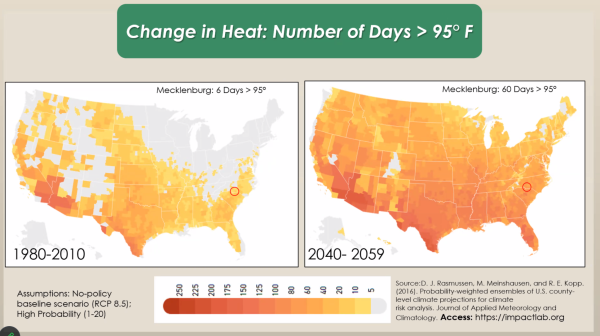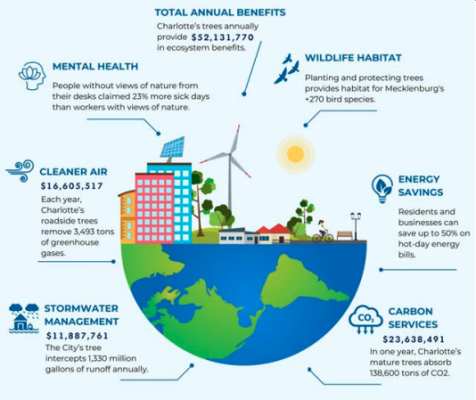Mecklenburg County is heating up. Could trees be the answer?
This week, the Environmental Stewardship Committee held their May meeting. There was only one item on the agenda: the tree canopy in Mecklenburg County. Couldn’t make the meeting? Here’s a recap!
Key takeaways
- Heat kills more Americans than flooding, tornadoes, and hurricanes combined every year. Trees can help us lower those deaths.
- If we continue with business-as-usual, it’s likely that Mecklenburg County’s tree canopy coverage will be less than 35% by 2040 which would result in a 2 degree increase in temperature.
- A balance of using existing tools, retaining and rethinking trees as infrastructure, and continuing to plant will forge our way to a robust, equitable tree canopy.
- The Tree Canopy Action Plan (TCAP) is the City’s guiding tree policy.
- The Urban Tree Canopy Analysis conducted in 2022 found that canopy has been declining slower than previously thought (down 0.5% from 47.8% in 2018).
Urban heat presentation
To kick off the meeting, the committee received a presentation from Dr. Douglas Shoemaker, Director of Research at UNCC’s Center of Applied GIS (Geographic Information Systems). He began with the shocking fact that heat kills more Americans than flooding, tornadoes, and hurricanes every year. This is because we do not have infrastructure in place to address extreme heat like we do for other natural disasters. He also shared that studies have shown that areas without trees in the U.S. can be up to 20 degrees hotter, resulting in 47% higher cooling costs.

Graphic: UNCC’s Center of Applied GIS
With this in mind, Dr. Shoemaker introduced a sardonic thought experiment: how to DIY a heat island (geographic area of extreme heat). Here are the steps:
- Rapidly urbanize and encourage building in a sprawling manner
- Replace trees with impervious surface
- Underinvest in neighborhoods
- Employ weak planting tools
- Wash, rinse, and repeat
With Mecklenburg County losing three football fields worth of trees every day, Shoemaker points out that we are well on our way to creating a heat island. We would need to plant 35,000 trees each year to return to 2012 canopy coverage of 49%. Unfortunately, we are physically unable to do this. Our current planting capacity is between 5,000 and 7,000 trees each year. If we continue with business-as-usual, Mecklenburg County is looking at less than 35% tree canopy coverage by 2040. Without taking other environmental factors into consideration, this will increase our temperature by 2 degrees.
So what can be done? Most residents don’t realize that trees on their property are their responsibility. When a tree is sick or dies, it is rarely replaced. It doesn’t help that tree upkeep and replanting can be expensive, which is especially burdensome for lower-income residents.
Shoemaker suggests providing a program to neighborhoods that teaches residents how to take care of their trees and assists them in doing so. Similarly, the development community needs to be good stewards of the environment in neighborhoods where they work by including tree planting and protection as a part of their procedure. This will require a mental shift – trees need to be considered valuable infrastructure, not pleasant amenities.
Planting alone will not solve the problem. Shoemaker argues that a balance of using existing tools, retaining and rethinking trees as infrastructure, and continuing to plant will forge our way to a robust, equitable tree canopy.
After Shoemaker’s presentation, county commissioners had a chance to ask questions. Commissioner Jerrell inquired about the economic value of trees, and Shoemaker confirmed that Mecklenburg County’s trees contribute $10M per year in ecosystem services (flood mitigation, water purification, pollination, and cultural benefits to name a few) and much more in increased property values and health benefits.
Commissioner Altman asked about the maximum legislative authority that both the City and County have to address tree canopy needs. County staff shared that most of the authority lies with the City, but a fair amount also depends on the state General Assembly. The only tool the County currently has is acquiring land to protect the trees on it.
Tree canopy policy update
Next, the City of Charlotte’s Chief Urban Forester, Tim Porter, updated the Committee on Charlotte’s tree canopy policies. There are three adopted City initiatives focused on trees:
- Tree Canopy Action Plan (2021)
- Urban Forest Master Plan (2017)
- 2050 Tree Canopy Goal (2011)
The Tree Canopy Action Plan (TCAP) was intended to be a comprehensive effort in line with Goal 7 in the 2040 Comprehensive Plan. There are several tools at the City’s disposal to implement the TCAP, including preservation and planting requirements in the Unified Development Ordinance, a Tree Ordinance that protects street trees and heritage trees, and a Tree Canopy Preservation Program to name a few.
The Urban Tree Canopy Analysis was completed in 2022 to serve as baseline data for future tree canopy efforts and policy work. The analysis found that canopy has been declining slower than previously thought (down 0.5% from 47.8% in 2018). However, only 9% of Charlotte’s tree canopy covers impervious surface and most of the canopy gains have occurred by the county borders. Further analysis is expected to be conducted in late 2024.
Overall, both elected officials and the public still appear eager to aim for the 2050 Tree Canopy Goal of 50%. Right now, we are not on track to achieve that goal, but with the balanced strategy outlined in Dr. Shoemaker’s presentation, we may be able to get there.
For more on the benefits of trees in Charlotte, take a look at the graphic below. Clearly, our community is better when we support trees.

Graphic: I-Tree, Arbor Day Foundation, EPA
Sustain Charlotte’s take
We recognize that a healthy tree canopy is essential to supporting human health, especially for people who need shaded streets for walking, biking, and riding transit. While our work isn’t centered on tree canopy like our friends at TreesCharlotte, we support trees through our advocacy on the Unified Development Ordinance. As, Dr. Shoemaker pointed out, we want to ensure that trees are considered necessary infrastructure in our development regulations and not amenities that can be removed.
Want to join the conversation? We are hosting a Sustain Charlotte Social on July 25 that will focus exclusively on trees and urban heat! We’ll have presentations from the City’s urban forestry team and UNCC professors whose research digs into heat in Charlotte. A registration link will be shared in June, but for now, mark your calendars! We look forward to seeing you there.
Thanks for reading!
As a nonprofit, community support is essential for us to keep doing what we do — including providing free articles like this. If you found this article helpful, please consider supporting Sustain Charlotte.
Want to stay in the loop? Subscribe to our weekly newsletter and follow us on Instagram, Facebook, and X.
